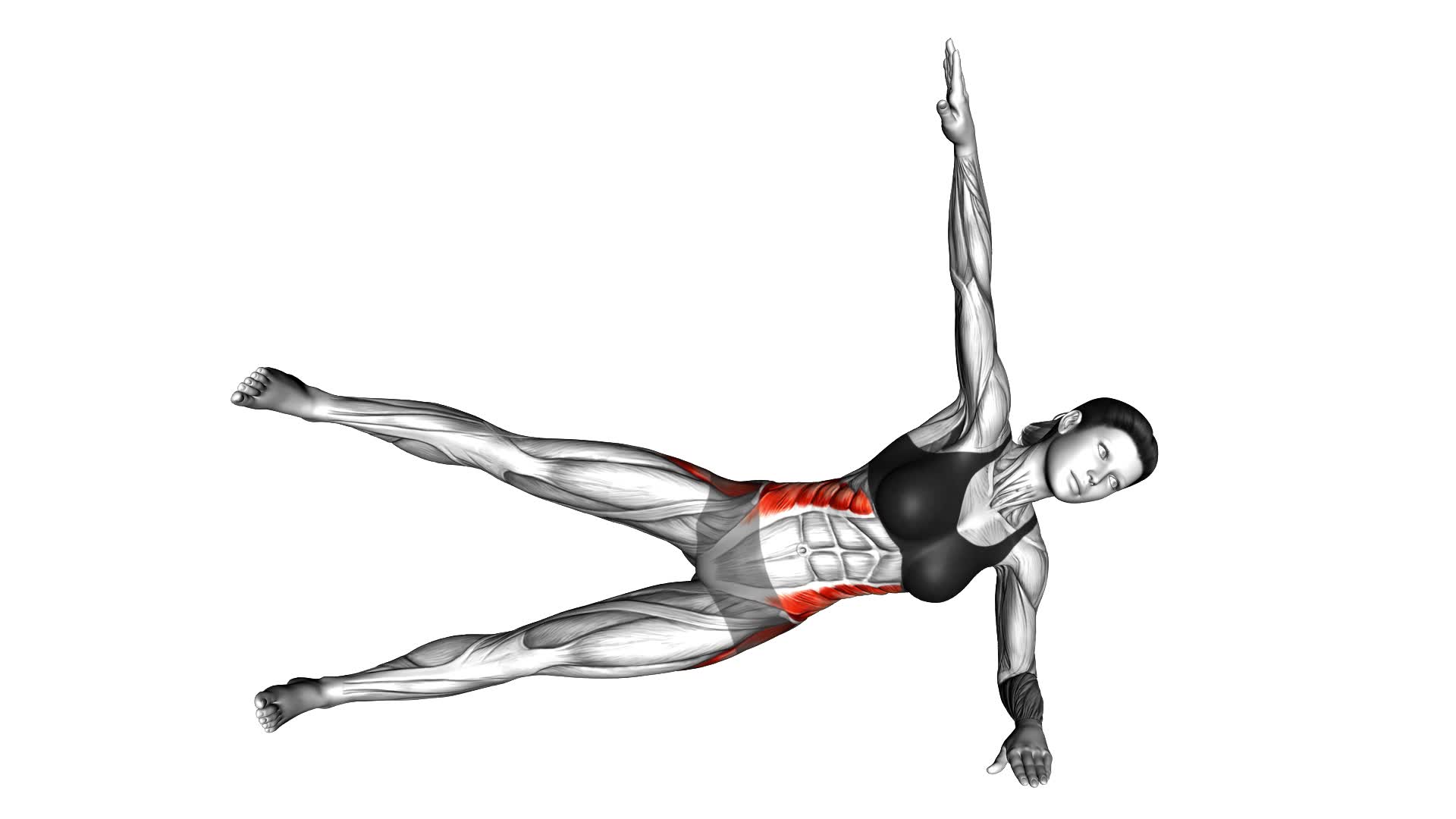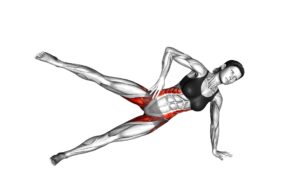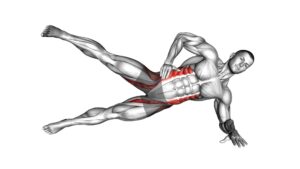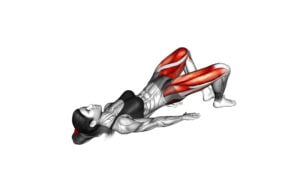Side Bridge Hip Abduction (star) (female) – Video Exercise Guide & Tips

Are you looking for a challenging exercise to strengthen your hips and core? Look no further than side bridge hip abduction!
Watch This Exercise Video
In this video exercise guide, you'll learn the proper form and technique to effectively target your glutes and outer thighs. We'll also provide modifications and progressions to suit your fitness level.
Avoid common mistakes and get tips on incorporating this exercise into your workout routine. Get ready to feel the burn and see results!
Key Takeaways
- Side Bridge Hip Abduction strengthens core muscles and improves overall stability and posture.
- It targets the gluteus medius and minimus muscles for hip stability.
- It reduces the risk of lower back pain and enhances balance to prevent falls and injuries.
- The exercise can be modified and enhanced with resistance bands, unstable surfaces, and additional leg movements for increased engagement.
Benefits of Side Bridge Hip Abduction
Side Bridge Hip Abduction is a highly effective exercise that offers numerous benefits, particularly in terms of core strengthening and hip stability. By engaging the core muscles, such as the transverse abdominis and obliques, this exercise helps to improve overall core stability, which is crucial for maintaining proper posture and preventing lower back pain.
Additionally, Side Bridge Hip Abduction targets the gluteus medius and minimus muscles, which are responsible for stabilizing the hips. Strengthening these muscles can enhance balance and stability, reducing the risk of falls and injuries.
Furthermore, this exercise can also improve hip mobility and flexibility, leading to better performance in sports and activities that require lateral movements.
By incorporating Side Bridge Hip Abduction into your fitness routine, you can reap these benefits and achieve a stronger core and more stable hips.
To perform Side Bridge Hip Abduction, you'll need a few pieces of equipment.
Equipment Needed for Side Bridge Hip Abduction
To perform Side Bridge Hip Abduction, you'll need a few pieces of equipment. One essential item is a resistance band. This elastic band provides the necessary resistance to challenge your muscles during the exercise. Resistance bands come in different levels of resistance, so choose one that suits your strength and fitness level.
Additionally, you'll need a mat or a comfortable surface to lie on. This will provide support and cushioning for your body as you perform the exercise. Lastly, make sure you have enough space around you to move freely without any obstructions.
It's important to note that while resistance bands can enhance the effectiveness of the Side Bridge Hip Abduction exercise, they aren't mandatory. You can still perform the exercise without them by relying solely on your bodyweight. This makes it a versatile exercise that can be done anywhere, even in the comfort of your own home.
However, using resistance bands can add an extra challenge and help you build strength and stability in your hip muscles. So, if you have access to resistance bands, it's worth incorporating them into your workout routine.
Proper Form and Technique for Side Bridge Hip Abduction
To perform Side Bridge Hip Abduction with proper form and technique, you should aim to engage your core and hip muscles consistently throughout the exercise. This will help you maximize the benefits of the exercise and prevent any potential injuries. Here are some important tips to ensure you maintain proper form and technique:
- Start by lying on your side with your forearm directly beneath your shoulder and your legs extended straight.
- Lift your hips off the ground, creating a straight line from your head to your heels.
- Engage your core by pulling your belly button towards your spine and squeezing your glutes.
- Slowly lift your top leg, keeping it straight, while maintaining stability in your hips and core.
- Pause for a moment at the top, then lower your leg back down with control.
By following these tips, you can ensure that you're performing Side Bridge Hip Abduction correctly and effectively.
However, it's important to be aware of some common mistakes that people make during this exercise. These include:
- Allowing your hips to sag or rotate during the movement.
- Not fully engaging your core, leading to decreased stability and effectiveness.
- Raising your leg too high, which can put unnecessary strain on your hip joint.
Modifications and Progressions for Side Bridge Hip Abduction
For added challenge and variety, you can incorporate different modifications and progressions into your Side Bridge Hip Abduction routine. These modifications allow you to target specific muscles and make the exercise more challenging as you progress.
One modification is to add a resistance band around your thighs. This will increase the resistance and engage your hip abductors even more.
Another modification is to perform the exercise on an unstable surface, such as a BOSU ball or a foam pad. This will challenge your core stability and further activate your hip abductors.
As you become stronger, you can progress to more advanced variations of the Side Bridge Hip Abduction.
One progression is to lift your top leg while maintaining the side bridge position. This will increase the demand on your hip abductors and challenge your balance.
Another progression is to perform the exercise with a weighted ankle cuff. This will add resistance and further strengthen your hip abductors.
Incorporating these modifications and progressions into your routine will keep you motivated and help you continue to see progress in your strength and stability.
Now let's move on to the next section to learn about common mistakes to avoid during side bridge hip abduction.
Common Mistakes to Avoid During Side Bridge Hip Abduction
To perform the Side Bridge Hip Abduction exercise correctly and avoid common mistakes, it's important to focus on engaging your core muscles properly and maintaining proper hip alignment.
Engage your core by pulling your belly button towards your spine and avoiding any arching or sagging of the lower back.
Additionally, make sure to keep your hips stacked and aligned with your shoulders throughout the movement to maximize the effectiveness of the exercise and prevent any strain or injury.
Engaging Core Muscles Properly
First, engage your core muscles properly to avoid common mistakes during side bridge hip abduction. Properly engaging your core muscles is crucial for maintaining stability and maximizing the effectiveness of the exercise. Here are some tips to help you engage your core muscles correctly:
- Start by lying on your side with your legs stacked on top of each other.
- Place your elbow directly under your shoulder and lift your hips off the ground, creating a straight line from your head to your feet.
- Draw your belly button in towards your spine to activate your deep core muscles.
- Squeeze your glutes to further engage your core and stabilize your hips.
- Maintain a neutral spine throughout the exercise, avoiding any excessive arching or rounding.
By engaging your core muscles properly, you'll be able to perform side bridge hip abduction with better form and avoid potential injuries.
Now, let's move on to the next section about maintaining proper hip alignment.
Maintaining Proper Hip Alignment
To maintain proper hip alignment during side bridge hip abduction, make sure to keep your hips in a neutral position throughout the exercise. This is crucial for hip stability and to prevent any unnecessary strain on the joints.
Many people make the mistake of allowing their hips to drop or rotate during the movement, which can lead to poor form and increased risk of injury. When performing the side bridge hip abduction, focus on keeping your hips stacked on top of each other, with your body forming a straight line from head to toe.
Engage your core muscles to help maintain this alignment and prevent any excessive movement in the hips.
Tips for Incorporating Side Bridge Hip Abduction Into Your Workout Routine
Enhance your workout routine by seamlessly integrating Side Bridge Hip Abduction. This exercise targets the muscles in your hips, glutes, and core, helping to improve your stability and strength. Here are some tips to help you incorporate Side Bridge Hip Abduction into your workout routine:
- Start with proper form: Lie on your side with your legs extended and stacked on top of each other. Place your forearm on the ground, perpendicular to your body, and lift your hips off the ground, creating a straight line from your head to your feet.
- Include side bridge variations: Once you have mastered the basic Side Bridge Hip Abduction, challenge yourself by incorporating variations. You can try lifting your top leg while maintaining the side bridge position or adding a resistance band around your thighs for added difficulty.
- Add it to your warm-up: Use Side Bridge Hip Abduction as part of your warm-up routine to activate your glute muscles and prepare your body for the workout ahead.
- Combine it with other exercises: Pair Side Bridge Hip Abduction with exercises like squats, lunges, or deadlifts to create a full-body workout routine that targets multiple muscle groups.
- Alternate with alternative exercises: To add variety to your routine, alternate Side Bridge Hip Abduction with other hip abduction exercises like clamshells or standing leg lifts.
Frequently Asked Questions
How Many Sets and Reps Should I Do for Side Bridge Hip Abduction?
To get the most out of the side bridge hip abduction exercise, it's important to know how many sets and reps to do. The number of sets and reps can vary depending on your fitness level and goals. Generally, it's recommended to start with 2-3 sets of 10-15 reps on each side.
This exercise targets your hips and glutes, improving stability and strength. Remember, there are also variations of the side bridge hip abduction that you can try to challenge yourself even more.
Can Side Bridge Hip Abduction Help in Reducing Hip Pain?
Side bridge hip abduction can be an effective exercise for strengthening your hip muscles and potentially reducing hip pain. By targeting the muscles in your hips, this exercise helps to improve stability and mobility, which can alleviate discomfort.
Additionally, side bridge hip abduction plays a crucial role in preventing hip injuries by strengthening the surrounding muscles and improving overall hip function. Incorporating this exercise into your routine can have a positive impact on your hip health.
Is It Necessary to Warm up Before Performing Side Bridge Hip Abduction?
Before performing side bridge hip abduction, it's important to warm up. Warming up helps prepare your muscles for exercise, reducing the risk of injury.
Incorporating side bridge hip abduction into your full body workout routine offers numerous benefits. It strengthens and stabilizes your core, improves hip mobility, and targets the gluteus medius muscle. This exercise can also help improve posture and balance.
Can Side Bridge Hip Abduction Help in Improving Balance and Stability?
Yes, side bridge hip abduction can definitely help improve your balance and stability. By engaging your core muscles and targeting the hip abductors, this exercise challenges your body to maintain a stable position.
The benefits of side plank exercises, including hip abduction, are well-documented. They not only strengthen your core, but also improve overall stability and enhance athletic performance.
Are There Any Alternative Exercises That Can Target the Same Muscles as Side Bridge Hip Abduction?
If you're looking for alternative exercises that target the same muscles as side bridge hip abduction, there are a few options you can consider.
One option is the side plank, which also engages the core and hip muscles.
Another alternative is the clamshell exercise, which specifically targets the gluteus medius and helps improve hip stability.
Both of these exercises can provide similar benefits to side bridge hip abduction in terms of balance and stability.
Conclusion
In conclusion, side bridge hip abduction is an effective exercise for strengthening the hips, core, and glutes. It helps improve stability and balance while targeting specific muscle groups. By incorporating this exercise into your workout routine, you can enhance your overall strength and prevent injuries.
Remember to maintain proper form and technique, and gradually increase the difficulty level as you progress. So, give side bridge hip abduction a try and experience the benefits it offers for improved fitness and body functionality.

Author
Years ago, the spark of my life’s passion ignited in my mind the moment I stepped into the local gym for the first time. The inaugural bead of perspiration, the initial endeavor, the very first surge of endorphins, and a sense of pride that washed over me post-workout marked the beginning of my deep-seated interest in strength sports, fitness, and sports nutrition. This very curiosity blossomed rapidly into a profound fascination, propelling me to earn a Master’s degree in Physical Education from the Academy of Physical Education in Krakow, followed by a Sports Manager diploma from the Jagiellonian University. My journey of growth led me to gain more specialized qualifications, such as being a certified personal trainer with a focus on sports dietetics, a lifeguard, and an instructor for wellness and corrective gymnastics. Theoretical knowledge paired seamlessly with practical experience, reinforcing my belief that the transformation of individuals under my guidance was also a reflection of my personal growth. This belief holds true even today. Each day, I strive to push the boundaries and explore new realms. These realms gently elevate me to greater heights. The unique combination of passion for my field and the continuous quest for growth fuels my drive to break new ground.







